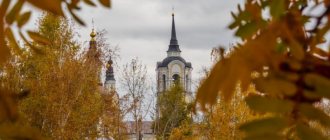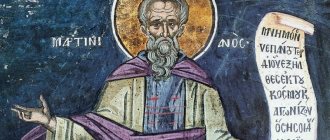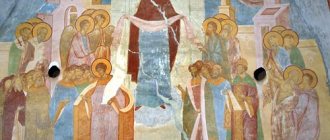Folk signs on September 14
- If this day is clear, then autumn will be windy; a stormy day will mean dry autumn.
- On this day it will be rainy - autumn will be stormy and cold.
- Gray and cloudy on this day - autumn will be long.
- There is a lot of web - the autumn is long and clear.
- If geese fly away on this day, expect early winter.
- If the geese fly away soon after Semenov's day, then it will soon be winter and vice versa.
- If the geese fly high, then the snow will not fall for a long time, but if they fly low, then the snow will fall soon.
- If the weather is warm on Semyon Day, then the whole winter will be warm.
- Dry and warm weather means late winter.
- If the first day of Indian summer is clear, then the whole autumn will be warm and windy.
- If in Indian summer the meadows are entangled in cobwebs, geese walk in herds, starlings do not fly, then the autumn will be long and windy.
- If Semyonov’s day is rainy, then autumn is rainy.
- A lot of cobwebs in Indian summer - for a clear autumn and cold winter.
- If Semyonov’s day is warm, then the whole winter will be warm
- If the south wind blows on this day, the winter will be rotten or warm.
- Indian summer is dry - autumn is wet.
- Sunny day - the whole autumn will be sunny.
- The starlings did not fly south - due to the long autumn.
- Dirt on the roads means rainy autumn.
- Spruce branches bent low - foreseeable frost.
- The wind blows - for rainy autumn.
- Flies bite painfully - bad weather.
- Typically, the period from September 14 to 21, called Indian summer, is sunny and relatively warm.
- On the Seeds, the spiked seeds were not harvested - they were considered lost.
- It is a sin to sow winter bread on Seeds.
- Cucumbers are pickled for Simeon the Stylite.
- Starting a hunt on this day means big catches all year round.
- Sit on a horse on September 14 - it will be calm and obedient all year.
- If the day turns out to be warm, you can start the housewarming party. Life in your new home will be happy. But on the eve of this event, a cat or rooster should be left in the new house - for good luck.
- If you take a smoldering firebrand from the oven and fumigate the field with it, like a censer, the next year will be fruitful.
How did the Byzantine New Year come to us?
Together with Orthodoxy. In Rus', the new year began on March 1, but after the Church Council in 1492, the calendar and church year began to begin on September 1. After the reforms of Peter I, the New Year was moved to January 1 (old style), and since 1918 - to January 1 new (as it is now). Since then, the New Year has remained exclusively a church holiday.
Troparion of the Indicta (Church New Year), tone 4:
Give thanks to Thy unworthy servant, O Lord, / for Thy great blessings upon us, / glorifying Thee, we bless, thank, sing and magnify Thy compassion, / and slavishly cry out to Thee in love: / Our Benefactor, our Savior, glory to Thee.
Glory: voice 3:
Thy blessings and gifts, / as a servant of indecency, having been vouchsafed, O Master, / we earnestly flow to You, giving thanks as much as we can, / and we glorify You, as the Benefactor and Creator, crying out: / glory to You, Most Generous God.
And now: voice 2:
To the Creator of all creation, / having established times and seasons in His power, / bless the crown of the summer of Thy goodness, O Lord, / keeping Thy people and city in peace / through the prayers of the Mother of God and save us.
Conspiracies of September 14
The plot will be useful for owners and gardeners
This conspiracy is read on September 14, the day of Simeon the Stylite, or, as he was otherwise called, Simeon the Summer Guide. They read the plot, bowing on four sides:
In the name of the Father and the Son and the Holy Spirit. On Holy Great Friday, when the enemy’s hands took the Lord Christ, they crucified Him on a high cross, the Jews stood around that cross, and put a crown of thorns on Christ. They laughed at Him and asked: “Where are you, Jesus, looking? Why are you, Jesus, trembling?” And the Lord God spoke in response: “I am trembling in pain and looking down at the ground, I see hordes of hungry evil rats.” Their teeth are greedy in blood. I wish with all my heart that these rodents would go away forever. As the Lord said, As Jesus Christ commanded, So be it: In my house, in the underground, in the stable, Rats and mice cannot live. In the name of the Father and the Son and the Holy Spirit. Now and ever and unto ages of ages. Amen.
What church holiday is today: September 14, 2021
According to the church calendar, September 14 is the day of remembrance of Saints Simeon, Martha, Jesus, Aifal, Ammun, Callista, Evod, Hermogenes and others.
Sputnik Georgia tells who these Saints were and why they are mentioned in the church calendar.
New Year
According to the Orthodox church calendar, September 14 marks the beginning of the indictment or the Church New Year (New Year).
Constantine the Great (306-337) decided to celebrate the beginning of the new year on September 1 (old style) in 312, which was associated, first of all, with the system of setting and collecting taxes, in other words, with the beginning of the new financial year.
© photo: Sputnik / Mikhail Mokrushin
Church New Year and gambling with time
The Christian Church did not immediately accept this tradition - clergy began to celebrate the beginning of the new year on September 14, according to the new style, in the 6th century.
The tradition of celebrating the Church New Year passed from Byzantium to Rus', although the people did not have a single date for celebrating the New Year for a long time, even after the adoption of Christianity. New Year's days were most often recognized as days close to the spring equinox.
The Moscow Church Council finally determined the date of the New Year - September 1 (September 14 according to the new style) - only in 1492.
Peter the Great, focusing on Europe, abolished the previous tradition of calculating dates from the Creation of the world, and ordered dates to be counted from the Nativity of Christ. He ordered the New Year to be celebrated seven days after Christmas. In a new way, the New Year was first celebrated in 1700.
Russia switched from the Julian to the Gregorian calendar, adopted in Europe, in 1918. The Orthodox Church has not switched to the new style; accordingly, all church holidays are celebrated according to the Julian calendar, including the New Year.
Simeon the Stylite
According to the church calendar, on September 14 the Monk Simeon the Stylite and his mother Martha are commemorated.
The future Saint was born into a Christian family in the village of Sisan in Cappadocia. Simeon began tending his father's sheep at the age of 13. Once hearing the Gospel beatitudes in church, he was shocked by their depth. Having decided to become a monk, at the age of 18 he left his parents’ home and took monastic vows in a nearby monastery, where he spent some time in monastic endeavors.
© Sputnik / Alexander Imedashvili
How a Saracen became a Georgian monk - the miracles of the Shio-Mgvim Monastery
Then he retired to the Syrian desert, where he laid the foundation for a new type of asceticism - pillarism. Having built a pillar several meters high, the monk, settling on it, almost continuously prayed and reflected on God.
The monk gradually increased the height of the pillar on which he stood. Its last pillar was 40 cubits high, and a double fence was built around it so that crowds of people would not disturb the prayerful concentration of the monk.
Women were not allowed outside the fence at all. The monk did not make an exception even for his own mother - she died, clinging to the fence surrounding the pillar, without ever getting a meeting. The monk asked to bring the coffin to him - the Saint said goodbye to his deceased mother reverently and her dead face shone with a blissful smile.
The monk spent 80 years in intense monastic labors, of which 47 he stood on the pillar. God allowed him to perform truly apostolic service in such unusual conditions - many pagans accepted Baptism, shocked by the moral fortitude and physical strength that the Lord bestowed on His ascetic.
His closest student Anthony was the first to learn about the death of the saint. Alarmed that his mentor had not shown himself to the people for three days, he climbed the pillar and found his dead body bowed in prayer. This happened in 459.
Joshua
According to the church calendar, on September 14 they commemorate Saint Joshua, the leader of the people of Israel after the death of the prophet Moses, who led the Jewish people into the Promised Land.
© Sputnik / Alexander Imedashvili
Stories of Georgian monks who gave their lives for their faith
The Lord, through Joshua, to whom Archangel Michael appeared, showed great miracles. So, the Jews passed through the Jordan River as if on dry land. The walls of the city of Jericho, besieged by the Jews, fell of their own accord after the Ark of the Covenant was carried around the city for seven days. In addition, the leader of the Israelite people, by God's command, stopped the movement of the sun during the battle with the enemy and extended the day until victory was won.
After the end of the war, Joshua divided the Promised Land between the 12 tribes of Israel - he died at 110 years old, commanding the people to keep the law of Moses. This happened in the 16th century BC.
Aifal
According to the church calendar, on September 14 they commemorate the martyr Aifal, who suffered for the faith in the 4th century.
Saint Aifal was a deacon. The martyr for confessing the name of Christ was stoned to death in 380 by order of the Persian king Sapor II.
Holy Martyrs
According to the church calendar, on September 14, 40 Christian virgins and Deacon Ammun, who enlightened them with the light of the faith of Christ, are commemorated.
Christian women and a deacon, under the Roman emperor Licinius, died as martyrs for Christ in the city of Adrianople of Macedonia at the beginning of the 4th century. The ruler of Vavd, in order to force the martyrs to renounce, subjected them to cruel torture.
They were then sent to Iraklia, where they were again subjected to severe torture to force them to worship idols, but the martyrs courageously refused to renounce. After prolonged torture, Ammun and eight virgins were beheaded, ten Christian women were burned, six died after a hot iron was placed in their mouths, six were stabbed with a knife, and the rest were hacked to death with swords.
Callista, Evod and Hermogenes
According to the church calendar, on September 14 they commemorate the martyrs Callista and her siblings - Evoda and Hermogenes, who suffered for their faith.
Callista, Evod and Hermogenes were Nicomedia Christians - they appeared before the court of a pagan ruler for confessing their faith. They were executed for refusing to sacrifice to pagan idols. This happened in 309.
Name day
According to the church calendar, on September 14th the name day is celebrated by Marfa, Tatiana, Natalia and Semyon.
The material was prepared based on open sources
The New Year, farewell to the old and the beginning of the new year, is celebrated by the church on September 14
Today, September 14, 2021, a new church annual cycle begins.
In distant Byzantium, after a 15-year period, on September 14 (according to the old calendar, September 1), the harvest ended and the tax was collected. This money was needed for benefits that the state gave to retired soldiers who had served in the army for 15 years. Tax is translated as “indict”, so the New Year is also called the beginning of the indict.
Rus' began to celebrate this holiday as a church-state holiday at the end of the 15th century. And even when Peter I decided to celebrate the civil New Year on January 1, the New Year was still preserved on the existing dates.
In the modern world, the holiday of the Church New Year is no longer associated with taxes or the army.
In the new church year for Orthodox Christians, the first big holiday is the Nativity of the Virgin Mary, and at the end of the year, Her Dormition is celebrated, which seems to mean the flow from temporary life to eternal life.
With the beginning of the indictment, the life of a Christian begins, given by the Lord for salvation, for cleansing from sinful passions, and the whole coming year should become spiritual in content and meaning.
Traditions of celebrating the New Year in Rus'
After Epiphany in 988, Rus' also adopted the Byzantine calendar - from the creation of the world. But until the 15th century, the civil year in Rus' began on March 1. Only in 1492 did the merger of the civil and church new years take place—September 1 officially became the beginning of the year. For two centuries it was a church and state holiday. On this day, a special festive service was performed - the “rite of summer service”, during which the bishop with a procession went out to the city square, where festive chants were sung, the Apostle and the Gospel were read, and then, while the troparion of the holiday was sung, everyone went to the temple, where the Divine Liturgy was celebrated. The main celebration took place in Moscow on the Kremlin’s Cathedral Square. Giovanni Compani , an Italian traveler of the 16th century, describes it
A platform is erected on the square, onto which the Metropolitan and the Grand Duke rise and from there announce the end of the year. The Metropolitan, according to custom, sanctifies the water and sprinkles this water on the prince and the people standing around, making the sign of the cross over both the prince himself and his sons, praying for their long and happy life, and at this time the people shout loudly: “To our Great Sovereign and children May he live for many years !” At the same time, everyone joyfully congratulates each other, wishing everyone a long life.
In 1699, Peter I introduced the European calendar in Russia (from the Birth of Christ) and moved the civil new year to January 1. Since then, only a church holiday has been celebrated on September 1, which has retained the ancient name “ beginning of the indica .” Since the first schools were parochial, education in them began with the church new year - on September 1. The Civil New Year is now celebrated on January 1, and the school year, as in the old days, begins in September.
Another useful reading: Library of the Russian Faith Teaching on the beginning of the indictment. Great Menaion of Cheti →
Read online in original
Historical events
786 - Harun Al-Rashid (the prototype of the character of the same name from One Thousand and One Nights) becomes the ruler of the Abassid Caliphate.
1224 - bleeding wounds appeared on the body of Saint Francis of Assisi - stigmata.
1741 - after 23 days of continuous work, the German composer G. Handel completed the oratorio “Messiah”.
1752 - Britain and its colonies adopted the Gregorian calendar.
1867 - The first volume of Karl Marx's Capital was published.
1939 - I. I. Sikorsky’s first helicopter, VS-300, took off in the USA. The car was driven by the designer himself.
1959 - The Luna 2 spacecraft reached the lunar surface for the first time in the world.
Charles Gibson. "First quarrel." Photo: Wikipedia
Martyrs of the 40 fasting virgins and the hieromartyr Ammun of Irakli, deacon, their teacher
These holy virgins lived in the 4th century. and came from the city of Adrianople in Thrace. Under the leadership of Deacon Ammun, they followed Christ along the path of asceticism and virginity to the Kingdom of Heaven. The virgins confessed Christ for the first time before Vavd, the ruler of the city. Then, when they were released, they gathered in the house of Kelsina, who belonged to one of the most noble families in the city. Ammun, their spiritual father, calling each by name, said: “Be courageous in the struggle, so that Christ, sitting at the gates of the Kingdom of Heaven, will also greet you each by name and call you to enjoy eternal life.”
Appearing again before the ruler, the virgins refused to make sacrifices to false gods and crushed the idols with prayers. Then Vavd ordered to subject them to severe torture. But the virgins continued to pray and were as if alien to their own bodies.
A pagan priest was present during the torture. Suddenly, Divine wrath lifted him into the air, and he hung above the ground for several hours, and then fell down and gave up the ghost. After this, the executioners hanged St. Ammun, they removed the skin from his sides, then they put a red-hot iron helmet on his head. However, the saint remained unharmed.
Then he, along with his spiritual children, was sent to Vereya, and then to Heraclea, so that they would appear before the emperor Licinius (c. 321–323). Along the way, the Lord appeared to the saints and inspired them to spiritual exploits. Arriving in Heraclea, they came to the place of the martyrdom of St. Glyceria. Late at night during prayer, the saint appeared to them, saying that she had been waiting for them for a long time, and called on them to join the choir of Angels and saints.
The next day, the holy virgins and their spiritual father were given over to be torn to pieces by wild beasts. The martyrs stood and prayed - the animals did not dare to touch them. Then the fire was built. While the flames were burning, the virgins prophesied to Licinius the imminent defeat and victory of Christianity under the auspices of St. Konstantin. Having made the sign of the cross, ten holy virgins threw themselves into the fire, singing. Eight others, along with their spiritual father Ammun, had their heads cut off. Ten more went to the Lord, struck in the throat and heart with a sword. Of the last twelve, six were beheaded with a sword, and six others had molten metal poured down their throats.
Died
• Martino Altomonte (1657-1745) - Italian painter.
• James Fenimore Cooper (1789-1851) - American writer (“The Pioneers, or At the Headwaters of the Susquehanna,” “The Last of the Mohicans,” “The Prairie,” “The Pathfinder,” “The Deerslayer, or the First Warpath”).
• José Echegueray y Eizaguirre (1832-1916) - Spanish writer, playwright, Nobel Prize laureate (1904).
• Isadora Duncan (1878-1927) - American ballerina, wife of Sergei Yesenin.
• Patrick Swayze (1952-2009) - American actor, dancer and singer-songwriter (films “Dirty Dancing”, “Ghost”).
Martino Altomonte. "Battle of Vienna". Photo: Wikipedia
The life secret of Simeon the Stylite
The Monk Simeon the Stylite is an ascetic who is one of the more revered. He was born into a poor Christian family. By the will of his parents, he was baptized. Even as a child he had a kind and calm character. He prayed with all his soul and served the Lord with pure thoughts.
In adulthood, he decided to become a monk, as befits such people, and fasted and prayed. Three years later, he settled and lived alone, in a small cell, which was carved out of the rock.
Being a great ascetic, Simeon decided to go to the desert and there he became the founder of the “pillar movement” (later many monks who led an ascetic lifestyle followed him). He built a small platform, which he placed on a fairly high pole, and lived there. This type of asceticism is considered the most difficult.
The righteous man did not have the opportunity to lie down; he spent both day and night in prayer and thought about God’s providence. Simeon managed to endure all weather changes and adhere to strict fasting. The only food he had was soaked wheat and water.
Many people came to the pillar where the ascetic lived so that he would heal their souls and bodies, because the righteous man had the gift of healing. The masses who came to Simeon repented of their sins and became Christians.
Thus, after remaining on the pillar for 80 years, the saint managed to live to 103 years. Simeon died praying.
Folk traditions and superstitions
The service of the “new summer” is connected with the prayerful memory of the saints falling on this day: Simeon the Stylite and 40 martyrs who suffered together with their teacher, Deacon Ammon , in the city of Andrianople under the Emperor Licinius .
Venerable Simeon the Stylite with his life in 22 hallmarks. Uglich, 2nd half of the 17th century
In Russia, everyday traditions were associated with the veneration of September 14 (September 1, old style) to the memory of the Venerable Father Simeon the Stylite In the language of the people, this day is called “ Seeds of the Summer ” or simply “ Seeds of the Day ”. The name “summer guide” was given to the day of the Venerable Father Simeon because around this time the end of summer comes, which can be concluded from the folk agricultural sayings: “ Semin’s day is a sower from the shoulders ,” or “ Semin’s day is down with the seeds ” (i.e. . end of sowing), “ On Semin’s day, before lunch, the plow, and after lunch, drive the plowman from the field ” (a hint that with the onset of September days, clear morning weather by noon often gives way to cold and bad weather). The time from Semin Day to September 8th was called “Indian summer” - this is the beginning of women’s and girls’ rural work, since from this day women begin to “stay up” in the evenings. “Semin Day” was an urgent day for the payment of quitrents, duties and taxes, and from this same day all conditions and agreements concluded by peasants among themselves and with merchants usually began and ended.
Born
• Heinrich Cornelius Agrippa of Nettesheim (1486-1535) - German physician and philosopher, mystic, major theorist of occultism.
• Pieter Lely, real name Pieter Van Der Fas (1618-1680), was an English painter of Dutch origin.
• Luigi Cherubini (1760-1842) - Italian composer, music teacher, music theorist.
• Charles Dana Gibson (1867-1944) - American artist and illustrator, creator of the Gibson Girls phenomenon, which represented the ideal of female beauty at the turn of the 19th-20th centuries.
• Nikolai Gnatyuk (born 1952) - Soviet and Ukrainian pop singer, People's Artist of the Ukrainian SSR.








